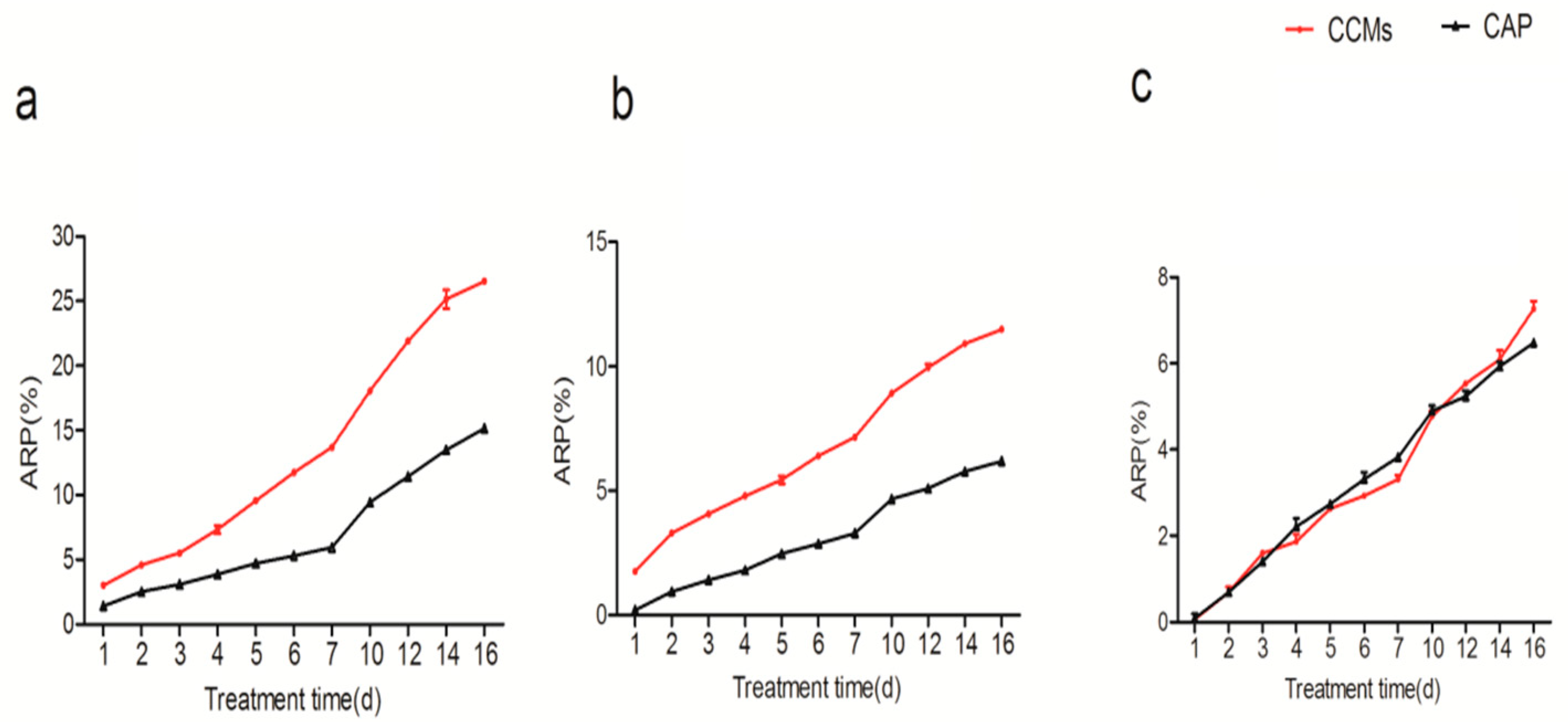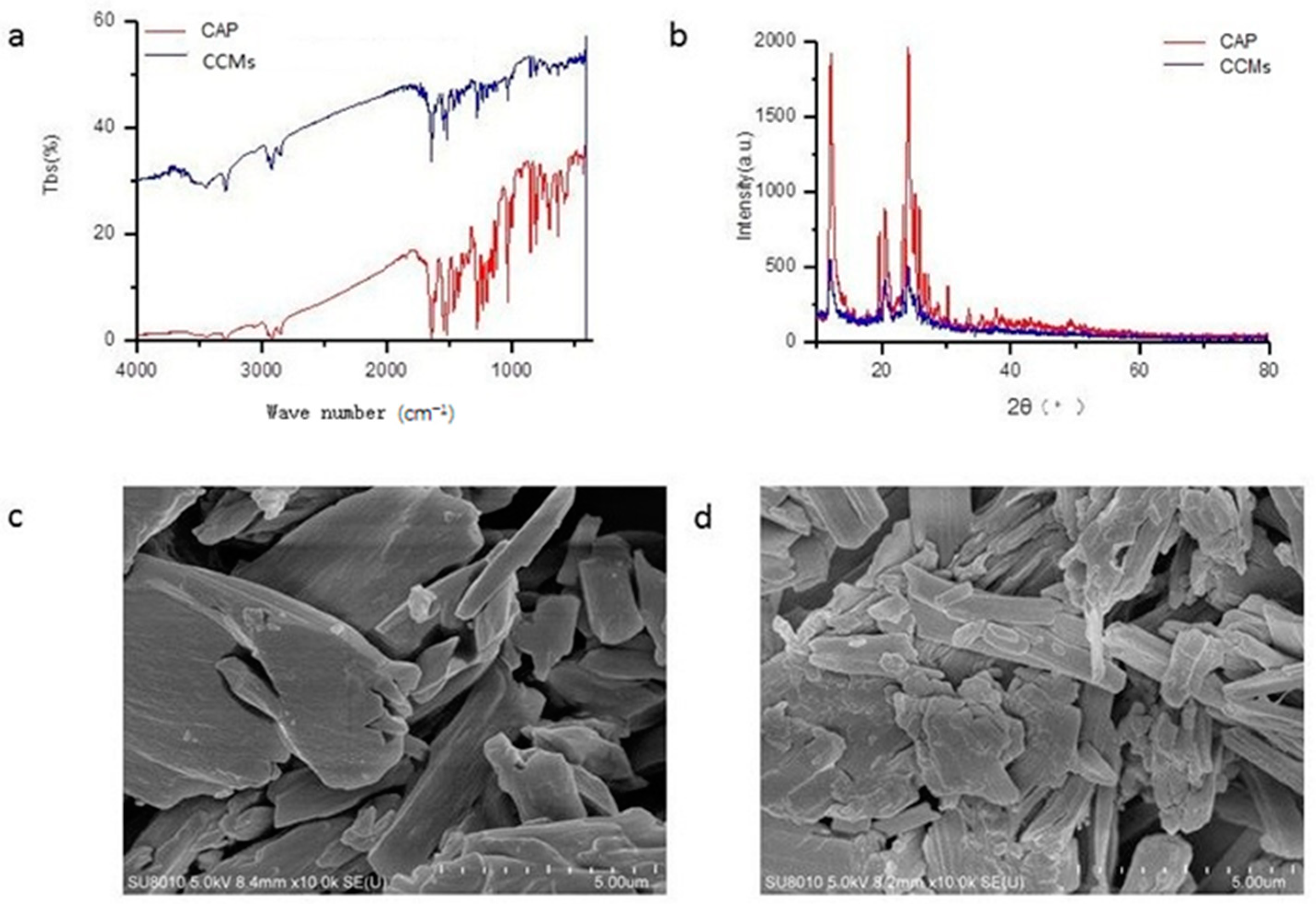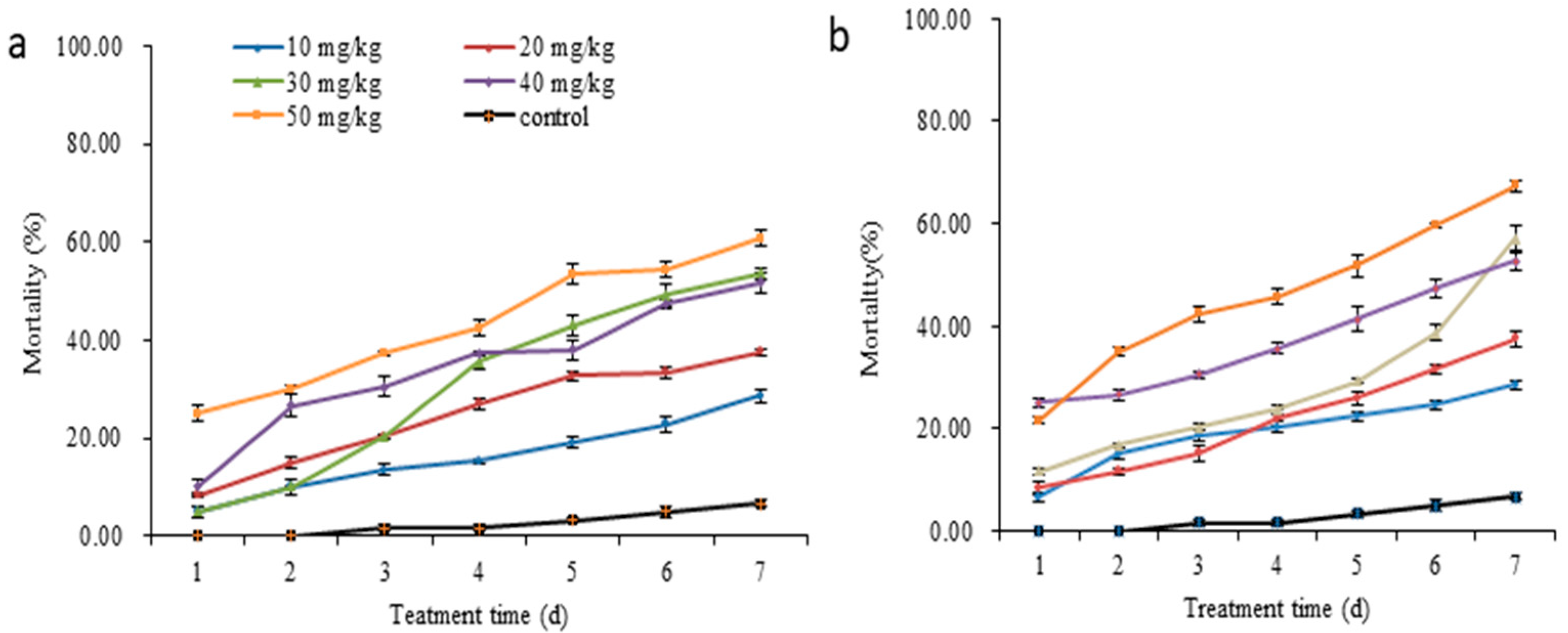Microencapsulation of Capsaicin in Chitosan Microcapsules: Characterization, Release Behavior, and Pesticidal Properties against Tribolium castaneum (Herbst)
Abstract
Simple Summary
Abstract
1. Introduction
2. Materials and Methods
2.1. Materials
2.2. Preparation of the CCMs
2.3. Efficiency of the CCMs
2.4. Release Effect of the CCMs
2.5. Structural Characterization of the CCMs
2.6. Effect of the CCMs on T. castaneum
2.6.1. Insects
2.6.2. Mortality of T. castaneum
2.6.3. Growth and Development of T. castaneum
2.6.4. Reproduction of T. castaneum
2.7. Data Analysis
3. Results
3.1. Loading Capacity and Release Behavior of the CCMs
3.2. Structure Characteristics of the CCMs
3.3. Effect of the CCMs on the Mortality of T. castaneum
3.4. Effect of the CCMs on the Development of T. castaneum
3.5. Effect of the CCMs on the Reproduction of T. castaneum
4. Discussion
5. Conclusions
Supplementary Materials
Author Contributions
Funding
Institutional Review Board Statement
Informed Consent Statement
Data Availability Statement
Conflicts of Interest
References
- Upadhyay, R.K.; Ahmad, S. Management Strategies for Control of Stored Grain Insect Pests in Farmer Stores and Public Ware Houses. World J. Agric. Sci. 2011, 7, 527–549. [Google Scholar]
- Njoroge, A.; Mankin, R.; Smith, B.; Baributsa, D. Effects of Hypoxia on Acoustic Activity of Two Stored-Product Pests, Adult Emergence, and Grain Quality. J. Econ. Entomol. 2019, 112, 1989–1996. [Google Scholar] [CrossRef] [PubMed]
- Haines, C.P. IPM for food storage in developing countries: 20th Century aspirations for the 21st Century. Crop Prot. 2000, 19, 825–830. [Google Scholar] [CrossRef]
- Roesner, J.; Wellmeyer, B.; Merzendorfer, H. Tribolium castaneum: A Model for Investigating the Mode of Action of Insecticides and Mechanisms of Resistance. Curr. Pharm. Des. 2020, 26, 3554–3568. [Google Scholar] [CrossRef]
- Islam, W. Eco-Friendly Approaches for the Management of Red Flour Beetle: Tribolium castaneum (Herbst). Indian J. Agric. Res. 2017, 5, 105–114. [Google Scholar]
- Boyer, S.; Zhang, H.; Lempenere, G. A review of control methods and resistance mechanisms in stored-product insects. Bull. Entomol. Res. 2012, 102, 213–229. [Google Scholar] [CrossRef]
- Myrna, C.; Rajeswaran, J.; Kerri, C.; Paul, E.; Nayak, M.K. Synergism Between Phosphine (PH3) and Carbon Dioxide (CO2): Implications for Managing PH3 Resistance in Rusty Grain Beetle (Laemophloeidae: Coleoptera). J. Econ. Entomol. 2020, 113, 1999–2006. [Google Scholar]
- Davies, C.R.; Wohlgemuth, F.; Young, T.; Violet, J.; Avery, S.V. Evolving challenges and strategies for fungal control in the food supply chain. Fungal Biol. Rev. 2021, 36, 15–26. [Google Scholar] [CrossRef]
- Beran, F.; Köllner, T.; Gershenzon, J.; Tholl, D. Chemical convergence between plants and insects: Biosynthetic origins and functions of common secondary metabolites. New Phytol. 2019, 223, 52–67. [Google Scholar] [CrossRef]
- Frydas, S.; Varvara, G.; Murmura, G.; Saggini, A.; Caraffa, A.; Antinolfi, P.; Tete, S.; Tripodi, D.; Conti, F.; Cianchetti, E.; et al. Impact of capsaicin on mast cell inflammation. Int. J. Immunopathol. Pharmacol. 2013, 26, 597–600. [Google Scholar] [CrossRef]
- Muangkote, S.; Vichitsoonthonkul, T.; Srilaong, V.; Wongs-Aree, C.; Photchanachai, S. Influence of roasting on chemical profile, antioxidant and antibacterial activities of dried chili. Food Sci. Biotechnol. 2019, 28, 303–310. [Google Scholar] [CrossRef] [PubMed]
- Dumitrache, M.; Jieanu, A.S.; Scheau, C.; Badarau, I.A.; Popescu, G.; Caruntu, A.; Costache, D.O.; Costache, R.S.; Constantin, C.; Neagu, M.; et al. Comparative effects of capsaicin in chronic obstructive pulmonary disease and asthma (Review). Exp. Ther. Med. 2021, 22, 917–929. [Google Scholar] [CrossRef] [PubMed]
- Popescu, G.; Scheau, C.; Badarau, I.A.; Dumitrache, M.; Caruntu, C. The Effects of Capsaicin on Gastrointestinal Cancers. Molecules 2020, 26, 94. [Google Scholar] [CrossRef]
- Fernando, M.-S.; Ligia, B.-A.; Mayra, D.-B.; Ignacio, I.-F. A review of a promising therapeutic and agronomical alternative: Antimicrobial peptides from Capsicum sp. Afr. J. Biotechnol. 2011, 10, 19918–19928. [Google Scholar]
- Wang, J.; Ji, Z.; Ji, Z.; Wei, S. Synthesis and insecticidal activity of capsaicin analogues. Chin. J. Pestic. Sci. 2020, 22, 892–896. [Google Scholar]
- Madhumathy, A.P.; Aivazi, A.-A.; Vijayan, V.A. Larvicidal efficacy of Capsicum annum against Anopheles stephensi and Culex quinquefasciatus. J. Vector Borne Dis. 2007, 44, 223–226. [Google Scholar]
- Hasyierah, M.S.N.; Norhidayah, A.; Rahayu, M.A.; Adilah, A.; Humaira, I.N. Botanical insecticide of chili and ginger extract on Nilaparvatalugens, brown planthopper. IOP Conf. Ser. Mater. Sci. Eng. 2020, 932, 012001–012007. [Google Scholar] [CrossRef]
- Li, Y.; Bai, P.; Wei, L.; Kang, R.; Chen, L.; Zhang, M.; Tan, E.K.; Liu, W. Capsaicin Functions as Drosophila Ovipositional Repellent and Causes Intestinal Dysplasia. Sci. Rep. 2020, 10, 9963–9974. [Google Scholar] [CrossRef] [PubMed]
- Rollyson, W.D.; Stover, C.A.; Brown, K.C.; Perry, H.E.; Stevenson, C.D.; McNees, C.A.; Ball, J.G.; Valentovic, M.A.; Dasgupta, P. Bioavailability of capsaicin and its implications for drug delivery. J. Control. Release 2014, 196, 96–105. [Google Scholar] [CrossRef]
- Tran, T.-T.; Hadinoto, K. A new solubility enhancement strategy of capsaicin in the form of high-payload submicron capsaicin-chitosan colloidal complex. Colloids Surf. A 2017, 520, 62–71. [Google Scholar] [CrossRef]
- Dias, M.I.; Ferreira, I.C.F.R.; Barreiro, M.F. Microencapsulation of bioactives for food applications. Food Funct. 2015, 6, 1035–1052. [Google Scholar] [CrossRef]
- Lombardo, S.; Villares, A. Engineered Multilayer Microcapsules Based on Polysaccharides Nanomaterials. Molecules 2020, 25, 4420. [Google Scholar] [CrossRef] [PubMed]
- Chien, R.-C.; Yen, M.-T.; Mau, J.-L. Antimicrobial and antitumor activities of chitosan from shiitake stipes, compared to commercial chitosan from crab shells. Carbohydr. Polym. 2016, 138, 259–264. [Google Scholar] [CrossRef] [PubMed]
- Raza, Z.A.; Khalil, S.; Ayub, A.; Banat, I.M. Recent developments in chitosan encapsulation of various active ingredients for multifunctional applications. Carbohydr. Res. 2020, 492, 108004–1080019. [Google Scholar] [CrossRef] [PubMed]
- Singh, R.; Upadhyay, S.K.; Singh, M.; Sharma, I.; Sharma, P.; Kamboj, P.; Saini, A.; Voraha, R.; Sharma, A.K.; Kumar Upadhyay, T.; et al. Chitin, Chitinases and Chitin Derivatives in Biopharmaceutical, Agricultural and Environmental Perspective. Biointerface Res. Appl. Chem. 2021, 11, 9985–10005. [Google Scholar]
- Fan, L.-h.; Jun, C.; Qin, S.-q. Carboxymethyl Chitosan and Its Application. Environ. Sci. Technol. 2009, 32, 84–87. [Google Scholar]
- Massella, D.; Giraud, S.; Guan, J.; Ferri, A.; Salaun, F. Textiles for health: A review of textile fabrics treated with chitosan microcapsules. Environ. Chem. Lett. 2019, 17, 1787–1800. [Google Scholar] [CrossRef]
- Yaneva, Z.; Ivanova, D.; Nikolova, N.; Tzanova, M. The 21st century revival of chitosan in service to bio-organic chemistry. Biotechnol. Biotechnol. Equip. 2020, 34, 221–237. [Google Scholar] [CrossRef]
- Valle, J.A.B.; Valle, R.d.C.S.C.; Bierhalz, A.C.K.; Bezerra, F.M.; Hernandez, A.L.; Lis Arias, M.J. Chitosan microcapsules: Methods of the production and use in the textile finishing. J. Appl. Polym. Sci. 2021, 138, 50482–50501. [Google Scholar] [CrossRef]
- Nada, H.G.; Ali, H.E.A.; El-Behery, R.R.; Shanab, S.M.M.; Elshatoury, E.H. Nanoparticles Biosynthesized by Bacillus cereus Filtrate and Gamma Rays Enhancing Chlorella vulgaris Biomass and Lipid Production. J. Clust. Sci. 2022, 33, 2055–2068. [Google Scholar] [CrossRef]
- Cheng, W.; Lei, J.; Ahn, J.-E.; Wang, Y.; Lei, C.; Zhu-Salzman, K. CO2 enhances effects of hypoxia on mortality, development, and gene expression in cowpea bruchid, Callosobruchus maculatus. J. Insect Physiol. 2013, 59, 1160–1168. [Google Scholar] [CrossRef] [PubMed]
- Kavallieratos, N.G.; Athanassiou, C.G.; Peteinatos, G.G.; Boukouvala, M.C.; Benelli, G. Insecticidal effect and impact of fitness of three diatomaceous earths on different maize hybrids for the eco-friendly control of the invasive stored-product pest Prostephanus truncatus (Horn). Environ. Sci. Pollut. Res. 2018, 25, 10407–10417. [Google Scholar]
- Konopova, B.; Jindra, M. Juvenile hormone resistance gene Methoprene-tolerant controls entry into metamorphosis in the beetle Tribolium castaneum. Proc. Natl. Acad. Sci. USA 2007, 104, 10488–10493. [Google Scholar]
- Abbott, W.S. A method of computing the effectiveness of an insecticide. J. Econ. Entomol. 1925, 18, 265–267. [Google Scholar] [CrossRef]
- Lu, M.; Chen, C.; Lan, Y.; Xiao, J.; Li, R.; Huang, J.; Huang, Q.; Cao, Y.; Ho, C.T. Capsaicin-the major bioactive ingredient of chili peppers: Bio-efficacy and delivery systems. Food Funct. 2020, 11, 2848–2860. [Google Scholar] [CrossRef] [PubMed]
- Terron-Mejia, K.A.; Martinez-Benavidez, E.; Higuera-Ciapara, I.; Virues, C.; Hernandez, J.; Dominguez, Z.; Argüelles-Monal, W.; Goycoolea, F.M.; López-Rendón, R.; Goicochea, A.G. Mesoscopic Modeling of the Encapsulation of Capsaicin by Lecithin/Chitosan Liposomal Nanoparticles. Nanomaterials 2018, 8, 425. [Google Scholar] [CrossRef] [PubMed]
- Goycoolea, F.M.; Valle-Gallego, A.; Stefani, R.; Menchicchi, B.; David, L.; Rochas, C.; Santander-Ortega, M.J.; Alonso, M.J. Chitosan-based nanocapsules: Physical characterization, stability in biological media and capsaicin encapsulation. Colloid Polym. Sci. 2012, 290, 1423–1434. [Google Scholar] [CrossRef]
- Isaschar-Ovdat, S.; Shani-Levi, C.; Lesmes, U. Capsaicin stability and bio-accessibility affected by complexation with high-amylose corn starch (HACS). Food Funct. 2021, 12, 6992–7000. [Google Scholar] [CrossRef]
- Jing, H.; Du, X.; Mo, L.; Wang, H. Self-coacervation of carboxymethyl chitosan as a pH-responsive encapsulation and delivery strategy. Int. J. Biol. Macromol. 2021, 192, 1169–1177. [Google Scholar] [CrossRef]
- Chen, J.; Huang, G.-D.; Tan, S.-R.; Guo, J.; Su, Z.-Q. The Preparation of Capsaicin-Chitosan Microspheres (CCMS) Enteric Coated Tablets. Int. J. Mol. Sci 2013, 14, 24305–24319. [Google Scholar] [CrossRef]
- Kunjiappan, S.; Sankaranarayanan, M.; Kumar, B.K.; Parasuraman, P.; Babkiewicz, E.; Maszczyk, P.; Glodkowska-Mrowka, E.; Arunachalam, S.; Pandian, S.R.K.; Ravishankar, V. Capsaicin-loaded solid lipid nanoparticles: Design, biodistribution, in silico modeling and in vitro cytotoxicity evaluation. Nanotechnology 2021, 32, 095101. [Google Scholar] [CrossRef] [PubMed]
- Liu, S.; Yang, Q.; Zhang, J.; Yang, M.; Wang, Y.; Sun, T.; Maa, C.; El-Aty, A.M.A. Enhanced stability of stilbene-glycoside-loaded nanoparticles coated with carboxymethyl chitosan and chitosan hydrochloride. Food Chem. 2022, 372, 131343. [Google Scholar] [CrossRef] [PubMed]
- Wang, J.; Dong, X.; Chen, S.; Lou, J. Microencapsulation of capsaicin by solvent evaporation method and thermal stability study of microcapsules. Colloid J. 2013, 75, 26–33. [Google Scholar] [CrossRef]
- Malaikozhundan, B.; Vaseeharan, B.; Vijayakumar, S.; Thangaraj, M.P. Bacillus thuringiensis coated zinc oxide nanoparticle and its biopesticidal effects on the pulse beetle, Callosobruchus maculatus. J. Photochem. Photobiol. B 2017, 174, 306–314. [Google Scholar] [PubMed]
- Akyuz, L.; Kaya, M.; Mujtaba, M.; Ilk, S.; Sargin, I.; Salaberria, A.M.; Labidi, J.; Cakmak, Y.S.; Islek, C. Supplementing capsaicin with chitosan-based films enhanced the anti-quorum sensing, antimicrobial, antioxidant, transparency, elasticity and hydrophobicity. Int. J. Biol. Macromol. 2018, 115, 438–446. [Google Scholar] [CrossRef] [PubMed]
- Kulpreechanan, N.; Sorasitthiyanukarn, F.N. Preparation and Optimization of Capsaicin-Loaded Chitosan Nanoparticles as Delivery Systems Using Box-Behnken Design. Mater. Sci. Forum 2020, 998, 277–282. [Google Scholar] [CrossRef]
- Lee, H.-S.; Hieu, T.T.; Ahn, Y.-J. Oviposition-stimulating activity of (E)-capsaicin identified in Capsicum annuum fruit and related compounds towards Helicoverpa assulta (Lepidoptera: Noctuidae). Chemoecology 2006, 16, 153–157. [Google Scholar] [CrossRef]
- Maliszewska, J.; Wyszkowska, J.; Kletkiewicz, H.; Rogalska, J. Capsaicin-induced dysregulation of acid-base status in the American cockroach. J. Environ. Sci. Health Part B Pestic. Food Contam. Agric. Wastes 2019, 54, 676–680. [Google Scholar] [CrossRef]
- Koleva-Gudeva, L.; Mitrev, S.; Maksimova, V.; Spasov, D. Content of capsaicin extracted from hot pepper (Capsicum annuum ssp microcarpum L.) and its use as an ecopesticide. Hem. Ind. 2013, 67, 671–675. [Google Scholar] [CrossRef]
- Shimomura, K.; Suzuki, N.; Hattori, S. Synergistic repellent activity of hot and cool thermal-sense compounds against two stored product insect pests. J. Asia Pac. Entomol. 2018, 21, 482–484. [Google Scholar] [CrossRef]
- Faqir, Y.; Ma, J.; Chai, Y. Chitosan in modern agriculture production. Plant Soil Environ. 2021, 67, 679–699. [Google Scholar] [CrossRef]
- Khan, B.A.; Rashid, F.; Khan, M.K.; Alqahtani, S.S.; Sultan, M.H.; Almoshari, Y. Fabrication of Capsaicin Loaded Nanocrystals: Physical Characterizations and In Vivo Evaluation. Pharmaceutics 2021, 13, 841. [Google Scholar] [CrossRef] [PubMed]




| Processing Mode | Development Time of Fourth Larva to Adult Instar (Days) | Pupation Rate (%) | Emergence Rate (%) | Adult Weight (mg) | |
|---|---|---|---|---|---|
| Male | Female | ||||
| Control | 4.78 ± 0.20 a | 91.3 ± 0.90 c | 94.2 ± 0.50 b | 2.263 ± 0.012 b | 2.364 ± 0.011 b |
| CAP | 7.41 ± 0.20 b | 65.33 ± 0.88 a | 66.38 ± 0.60 a | 2.038 ± 0.011 a | 2.124 ± 0.015 a |
| CCMs | 7.59 ± 0.195 b | 69.6 ± 0.60 b | 65.73 ± 0.62 a | 2.029 ± 0.010 a | 2.142 ± 0.013 a |
Disclaimer/Publisher’s Note: The statements, opinions and data contained in all publications are solely those of the individual author(s) and contributor(s) and not of MDPI and/or the editor(s). MDPI and/or the editor(s) disclaim responsibility for any injury to people or property resulting from any ideas, methods, instructions or products referred to in the content. |
© 2022 by the authors. Licensee MDPI, Basel, Switzerland. This article is an open access article distributed under the terms and conditions of the Creative Commons Attribution (CC BY) license (https://creativecommons.org/licenses/by/4.0/).
Share and Cite
Cui, S.-F.; Wang, J.-W.; Li, H.-F.; Fang, R.; Yu, X.; Lu, Y.-J. Microencapsulation of Capsaicin in Chitosan Microcapsules: Characterization, Release Behavior, and Pesticidal Properties against Tribolium castaneum (Herbst). Insects 2023, 14, 27. https://doi.org/10.3390/insects14010027
Cui S-F, Wang J-W, Li H-F, Fang R, Yu X, Lu Y-J. Microencapsulation of Capsaicin in Chitosan Microcapsules: Characterization, Release Behavior, and Pesticidal Properties against Tribolium castaneum (Herbst). Insects. 2023; 14(1):27. https://doi.org/10.3390/insects14010027
Chicago/Turabian StyleCui, Su-Fen, Jin-Wei Wang, Hai-Feng Li, Ran Fang, Xin Yu, and Yu-Jie Lu. 2023. "Microencapsulation of Capsaicin in Chitosan Microcapsules: Characterization, Release Behavior, and Pesticidal Properties against Tribolium castaneum (Herbst)" Insects 14, no. 1: 27. https://doi.org/10.3390/insects14010027
APA StyleCui, S.-F., Wang, J.-W., Li, H.-F., Fang, R., Yu, X., & Lu, Y.-J. (2023). Microencapsulation of Capsaicin in Chitosan Microcapsules: Characterization, Release Behavior, and Pesticidal Properties against Tribolium castaneum (Herbst). Insects, 14(1), 27. https://doi.org/10.3390/insects14010027






